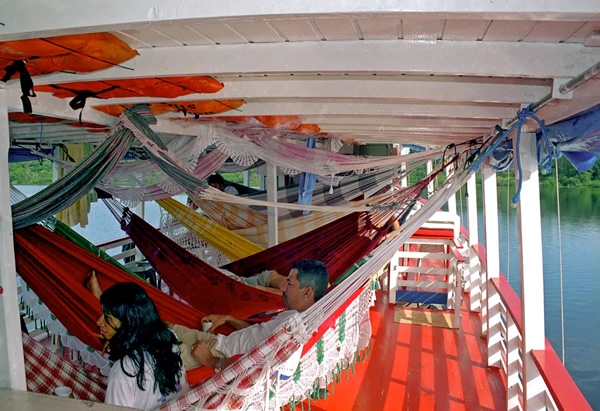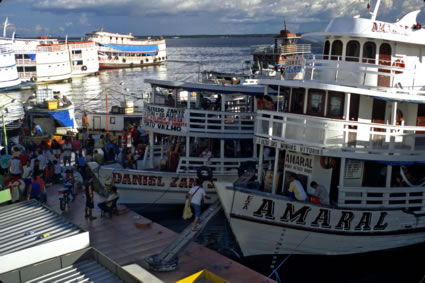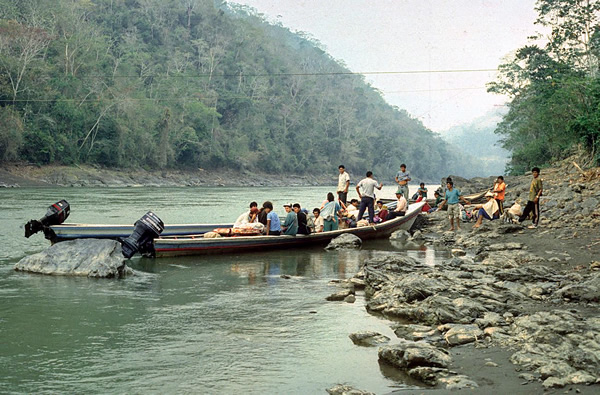Travel in South America by Boat
Tips for Independent Travelers Wishing to Enjoy the Amazon by Riverboat
By Volker Poelzl

|
The hammock deck of a small riverboat in Brazil.
© Volker Poelzl. All Rights Reserved.
|
South America is home to the world’s most extensive river system: the Amazon basin. The length of the Amazon River from the Atlantic Ocean to its source is in the distant Andes, just over 4,400 miles, only slightly shorter than the Nile, the world’s longest river. The network of navigable rivers in the Amazon basin is huge, and boat travel is vital to the region’s transportation of goods and passengers. With a long and heavy rainy season (December-April), the transportation system changes dramatically every six months. As a local in the Brazilian Amazon told me once: “When we travel to town, half the year we use the bus, the other time we travel by boat.”
Boat travel in the Amazon is a great experience but a challenge. I had romantic notions before my first boat trip, and I imagined floating downriver while relaxing in my hammock and watching the dense jungle pass by at arm’s length, with sightings of exotic animals and plants. However, the daily reality of traveling in the Amazon by boat is much more about basic creature comfort than watching the jungle and wildlife. The following travel tips derive from extensive trips on passenger boats in the Amazon, and they should help you plan your trip and have an enjoyable time. This article does not discuss jungle boat tours and cruises that travel companies and outfitters offer.
What to Expect
on a Passenger Boat
Passenger boat travel in the Amazon is a very rustic experience. Cabins only exist on the larger boats, which are small and stuffy, often equipped with noisy air conditioning. Most passengers prefer to travel cheaply and sleep on the open and free-for-all hammock deck. Since riverboats are usually the only connection to the outside world, they are always crowded. Sleeping quarters are tight, as there are no assigned hammock spaces, and each passenger vies for their own space on the sleeping deck. Food is rather bland and consists of crackers and coffee in the morning and rice, beans, and fried bananas with chicken for lunch and dinner.
If you plan on traveling in the Amazon by boat, you need more time than you might think. Journeying down the Urubamba and Ucayali rivers in Peru took so long that my one-month visitor permit expired before I could reach the Brazilian border. Fortunately, the immigration office in Iquitos was open on a Saturday morning, or I would have faced a fine at the Peruvian border with Brazil, where travelers get their exit stamps. Except for a few larger cities, such as Iquitos ( Peru) and Manaus and Santarem ( Brazil), most settlements in the Amazon are small and without immigration offices. So before you embark on your journey, ensure you have enough time to include potential delays.
The Amazon River is several miles wide below the confluence of the Marañon and Ucayali rivers in Peru, and you will not see much of the jungle, villages, or wildlife. The best places to visit the jungle up close and occasionally spot wildlife are the smaller tributaries of the Amazon, which are narrow enough so that the boats travel closer to the shore. Remember that boats hug the banks when traveling upstream, where the current is slower, and the boats do not use as much fuel. Most boats stay in the middle when traveling downstream, where the current is faster, and the river is deeper. In this case, you will not see more than the silhouette of the distant rainforest.
Among the most pleasant experiences of traveling by boat is the contact with the local people. Since there is nothing else to do, conversation is one of the best ways to pass the time. Sitting on the upper deck in the evening or at night, watching the stars, and exchanging stories with other passengers is a lot of fun — a great way to meet the locals and learn about their views and way of life. Therefore, speaking the local language will make the trip much more enjoyable if you plan on traveling by boat in South America. So bring along a phrasebook and a small dictionary to help you communicate.
A boat trip is also a great way to discover how the people in the Amazon live. If you travel upriver, the boat will hug the shore, and you will be able to observe the life of the locals and get an idea of the difficulties of life in this remote region dominated by a mighty and unpredictable river. In an isolated region only connected to the outside world by boat, the locals are utterly self-sufficient, and there is little time for idleness. At any time of day, you will see women washing clothes on the shore while children bathe nearby and men sitting quietly in dugout canoes with their fishing poles in the water. People work in small vegetable gardens, harvest fruit in the forest, and tend to small fields of cash crops, which they sell in the nearest town. Most of the locals live in simple thatched huts made from materials found in the forest, and they lack most amenities of modern life, such as electricity, roads, telephones, and easy access to education and health services. In this sense, a boat trip in the Amazon is also an extraordinary journey of discovery.
What You Need to Bring on a Riverboat
The most important item you need is a hammock. If you have never slept in one, it will take some getting used to. As mentioned above, some boats offer cabins with air conditioning, but most passengers prefer the affordable open passenger deck, where they feel the breeze. Hammocks are slung very close together, sometimes one on the other. Most riverboats are privately owned, and the captain never refuses a passenger, often leading to overcrowded boats and very tight sleeping quarters. While there is little you can do about it, I have successfully defended my space by telling arriving passengers that they cannot sling their hammocks on top of mine. The only privacy you can get is on the upper deck, where you can enjoy a few moments away from the crowded sleeping deck below. Some boats blast loud music, show movies, or have mediocre live entertainment, so you should ensure your hammock is nowhere near a speaker or TV. It is a good idea to bring earplugs, just in case.
You should also bring insect repellent, a hat, sunscreen, a roll of toilet paper, and extra snack food to offset the simple meals. Many of the larger passenger boats have a bar where you can buy snacks and drinks, but the selection is limited. Use longer stops to step ashore and purchase fresh fruit, snacks, and beverages near the dock. Hawkers often come on board during stops, offering baked goods and meals for passengers tired of the food on the boat. To best deal with the heat and humidity, bring light clothing. Everybody dresses casually and comfortably in shorts and short-sleeve shirts; most passengers wear flip-flops. It can get cool at night, so you should also bring comfortable pants, a sweatshirt, or even a sleeping sheet to cover yourself.
You need a yellow fever vaccination certificate to pass through some areas in the Amazon, also a requirement when entering Brazil. It is also a good idea to bring a few first aid items. After a few weeks of sleeping on boats in my hammock, I developed a painful backache, and the painkillers I had with me came in handy. Although malaria is present in the Amazon, mosquitoes rarely come onboard while the boat is moving. Still, put on long clothing at dawn and dusk and use insect repellent as a precaution. Ask around about health concerns before going on your trip. The locals often know more about recent outbreaks and health concerns than you can learn from government websites.
Prepare for the unexpected. In the dry season, boats often run aground in the upper tributaries of the Amazon, which can lead to extensive delays. When I traveled in Peru from Pucallpa to Iquitos, the boat was carrying a heavy load, and the river was so low that the captain decided to travel only during the day for better visibility. The boat took six days instead of the expected three days to reach its destination. Severe droughts in the Amazon have become more frequent in recent years, and you should ensure that your intended route is safe for boat travel.
It is essential to arrive at the boat early on the day of the departure. Most riverboats leave port around dusk, but it is a good idea to arrive at least 3 to 4 hours beforehand to secure a good spot for your hammock. If you sling your hammock in the front, you will be the first to be hit by wind and rain. If you are too far in the back, you will sense the diesel engine's heat, vibration, and fumes or the odors and noises emanating from the galley and bathrooms.

|
The busy port in Manaus, the largest city in the Amazon.
© Volker Poelzl. All Rights Reserved.
|
Hygiene and Food Safety
Bathrooms are combined washrooms, toilets, and showers, but they are cleaned with river water several times daily. It is best to line up for a shower just after the bathroom has been cleaned. You will be showering in river water, but it is much better than remaining sweaty all day, and the showers also provide pleasant cooling. It can get hot on the hammock deck, especially in the afternoon, even with the breeze from the boat’s movement and the wind.
Although the food is simple, I have found it safe and never had digestive problems. All meals are prepared fresh, and the galley usually has a freezer for the meat supply. All passenger boats in Brazil provide filtered drinking water from water fountains, which you should also use to brush your teeth. In Peru, however, the hygiene standards are not as high, and I made a point at every more extended stop to stock up on bottled water and soft drinks from small shops near the dock. You could also bring a water filter or water purification tablets to be safe.
Selecting a Boat
If you have a choice between several boats traveling the same route, I recommend choosing the newest, fastest, and largest boat. Large ships have stronger engines and travel faster. They usually have three decks: a cargo deck, a passenger deck, and a viewing deck, which makes the trip more comfortable. You should talk to the captain and ask him about the route and possible long stopover. Most boat owners allow you to come on board and look around before you buy a ticket. Inspect the bathrooms, the kitchen, as well as the hammock and roof deck to get an idea if the boat is clean and well maintained. Be sure to ask about filtered water as well as the type of food and drink sold at the bar. Although most passengers buy their tickets as they board the boat, you can also purchase tickets from ticket agents, especially in larger towns and cities.
There are also government boats that travel on the same routes as the privately owned boats. They are often older, slower, and less comfortable than private boats, but the tickets are also cheaper. Government boats also travel to remote areas without passengers or cargo to support a commercial ship. On such remote routes, boats may only travel once or twice a month. Therefore, if you are interested in a return trip, you should find out when there will be a boat to take you back. In Peru, cargo boats primarily transport passengers, and they are not nearly as comfortable and pleasant as the wooden passenger boats in Brazil. Passengers sling their hammocks between the cargo wherever there is room.
Routes to Consider

|
In the foothills of the Andes, boat travel is limited to small motorboats.
© Volker Poelzl. All Rights Reserved.
|
Not all countries that share the Amazon basin have regular year-round boat service. In some parts, boats are only available during the rainy season, when roads become impassible. On the upper tributaries of the Amazon in Peru, the melted waters and rainfall during the summer (Dec-April) feed the rivers so much water that they could become too dangerous for boat travel. Traveling downriver is the best way to experience boat travel in the Amazon. The trip is much shorter and cheaper because less fuel is used. You can travel downriver and reach the Amazon River on several tributaries, among them the Napo River (Ecuador/Peru), the Urubamba, Ucayali, Huallaga, and Marañon rivers in Peru, only to mention the largest ones. Brazil also has a large number of rivers with regular boat traffic, among them the Rio Solimões (as the upper Amazon is known in Brazil), Rio Madeira, Rio Purus, Rio Juruá, Rio Negro, and Rio Japurá.
On the upper tributaries of the Amazon in the Andean foothills, boat travel is limited to motorized canoes or medium-size motorboats. They do not follow any schedule, and you may have to wait in a small town or village for a few days before catching a ride. The boats always stop at night, and you should expect to sling your hammock in the hut of a local family for the night. In the Bolivian Amazon, the most important towns connect by roads, which remain open all year. In these areas, boat traffic is limited to barges transporting oil, grain, and timber, although they sometimes take passengers. The same is the case with the Paraguay River system that drains parts of Brazil, Bolivia, and Paraguay, where the only boats are cargo barges.
However, regardless of your route and the type of boat on which you travel, traveling by boat will give a first-hand impression of the Amazonian people, their culture, and their way of life. And despite the lack of creature comforts, a boat trip in the Amazon is a fascinating and unforgettable experience.
Volker Poelzl is a Living Abroad Contributing Editor for TransitionsAbroad.com. He has extensively traveled in the Amazon by boat. His most incredible river adventure was descending the Urubamba River, just downstream from Machu Picchu. He eventually reached the Atlantic Ocean in Brazil a few months later after descending the entire Amazon River by boat.
|
